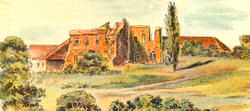Roshischtsche Parish History
The Parish of Roshischtsche (1862)
The first Evangelical settlers reached this region in 1816 from the Parish of Neudorf-Neubrow in Grodno Province. Cloth workers in greater abundance came after the first Polish Rebellion in 1832. A chapel was built in Welnianka (or Wolnanka) in 1837. Yet more settlers came into the counties of Luzk, Kowel and Wladimir-Wolynsk just before and after the second Polish Rebellion, including both Germans from Poland and from Germany. A parish was established for these counties with its administration in Roshischtsche in 1862. By that date, the colonies of Welnianka, Olganowka, Walerianowka, Tarnowola, Zapust, Stanislawka, Marianowka, Cecylowka, Stanislawowka, Antonowka, Wincentowka, Aleszkowicze, Josefin and Nowa Ziemia were already active Evangelical communities. The new parish was served for ten years by a vicar (Heinrich Wasem and then, in 1863, Eduard Johann Heinrich Rosenberger) before receiving its own pastor in 1872 in the person of Paul Hirsch. A stone church was dedicated in Roshischtsche in 1878. By the late 1880s, the parish counted 100 preaching places for 40,000 parishioners and needed to be subdivided. Tutschin Parish was split off from Roshischtsche in 1888 and Nowograd-Wolynsk Parish in 1889. Even after these divisions, Roshischtsche still could count about 18,000 parishioners in 1910.
During the rebuilding period after W.W. I, Generalsuperintendent Julius Bursche of the Warsaw Consistory placed western Volhynia (soon to become "Polish Volhynia" by the Treaty of Riga in 1921) under the administration of the Lublin Superintendent Alexander Eduard Schoenich. Theodor Bergmann was sent from Cholm to administer Roshischtsche and Wladimir-Wolynsk Parishes in 1919. (Erhard Torinus was similarly sent to serve two parishes, Rowno and Tutschin, to be followed by Georg Rusnok, who also served both parishes. In spite of the "polonizing" tendencies of Bursche and Schoenich, the Germans of the new "Polish" Volhynia were encouraged to maintain their German language and culture, at least for a time). Bergmann's successor, Rudolf Kersten, built a well-known home for the elderly in Roshischtsche in 1925. Also widely hailed throughout the area was Roshischtsche's annual Johannisfest, which drew thousands of visitors.
In 1938, Bishop Bursche arranged for the church in Jozefin to become an independent Parish, with Polish services, and he tried to force five German families in the neighborhood to become members. Pastor Henke supported their refusal to join. A similar case arose in the village of Olischkowitsch, where again Henke resisted Bursche's "polonizing" efforts to create another Polish parish.
Pastors in Roshischtsche Parish
| 1862 – 1863 | Heinrich Martin David WASEM, Vikar |
| 1863 – 1871 | Johann Heinrich Eduard ROSENBERGER, Vikar |
| 1872 – 1879 | Paul Ottokar Theodor HIRSCH, Pastor |
| 1887 – 1888 | Ernst ALTHAUSEN, Vikar |
| 1879 – 1903 | Georg Friedrich KERM |
| 1904 – 1906 | Arnold Gottfried HOFFMANN |
| 1908 – 1913 | Guido Robert Thaddäus RADASEWSKY |
| 1914 – 1915 | Friedrich Heinrich SCRIBA |
| 1919 – 1921 | Theodor BERGMANN |
| 1921 – 1924 | Rudolf KERSTEN |
| 1924 – 1940 | Rudolf Reinhold HENKE |
| 1938 – 1939 | Oskar KRAMPITZ, Vikar |
Evangelical Congregations in Roshischtsche Parish
| Alexandrowka+ | Kopatschewka (Kopaczowka)+ | Sapust (Zapust)+ (near Roshischtsche) |
| Alt-Rokin | Koschelowka (Koszelowka)+ | Sapust-Boratin+ |
| Apollonia-Babje+ | Marianowka+ (near Holoby) | Schitschinek (Zyczynek, Szczynik)+~ (possibly later in Wladimir Parish) |
| Bjeloschew (Bielaszow, Byeloschew)+ | Mathildow (Matyldow, Matuldow)+ (near Tortschin) | Serniki (Sernik)+ |
| Brischtsche I and II (Bryszcze)+ |
Michailowka+ | Stanislawowka+ (near Roshischtsche) |
| Demitrowka (Dmitrowka)+ | Milaszew | Stanislawowka+~ (near Bresalup) |
| Dombrowo-Goloby+ | Miroslawka+ | Stawiszyn |
| Dombrowo-Salasje+ | Nemer (Niemier, Nimier)+ | Swobodarka+ |
| Dombrowo-Witschin+ | Neu-Dorossin (Dorosin, Dorosinie Nowe)+ | Tagatschin (Tahaczyn)+ |
| Dubnik (Dubniki)+ | Nikolajewka+ (near Boddebecy) | Tarnowole (Tarnowola)+ |
| Friedrichowka (Frydrychowka)+ | Olganowka+ | Tortschin (Torczyn) |
| Glinischtsche (Gliniszcze)+ | Olischkowitsch (Oleszkowiec)+(with a wooden church) | Valerianowka (Walerjanowka, Styr Kolony)+ |
| Gross-Gluscha+ | Omelno+ | Vizentowka+ |
| Gross-Paproc | Oserze+ | Wincentowka-Klementowka |
| Helenow+ (near Zapust) | Plaschew (Plaszewo, Plaszowo, Johannestal)+ | Wolnanka (Wolnianka)+ |
| Helenowka-Sokul+ | Rokin+ | Zapust (Sapust)+ (near Roshischtsche) |
| Jozefin (Josefine)+ (near Kijasch or Kijaz) | Romanow I and II+ | Zapust-Boratin+ |
| Jozefin (Josefine)+(with a wooden church) (near Trostenez or Trostieniec) | Romanowka+ | Zyczynki |
| Julianow+~ (near Tortschin) | Roshischtsche (Rozyszcze)(with stone church) | |
| Klein-Gluscha+ | Sabara+ |
+ village with a school which was usually also used as a chapel (Betsaal)
~ village with a separate chapel (Kapelle or more commonly, Betshaus)
* villages where land was owned by the farmer (in contrast to those where it was leased from a nobleman)
Sources:
1. PINGOUD, G.: "Die evangelisch-lutherischen Gemeinden in Rußland", herausgegeben von der Unterstützungs-Kasse für Evangelisch-Lutherische Gemeinden in Rußland; Band 1: "Der St. Petersburgische und der Moskowische Konsistorialbezirk", St. Petersburg, 1909
2. KNEIFEL, Eduard: "Die evangelisch-augsburgischen Gemeinden in Polen 1555 - 1939", Selbstverlag des Verfassers, Vierkirchen 1971


